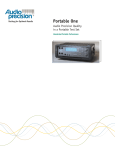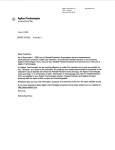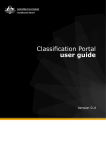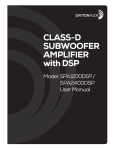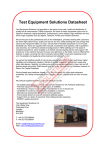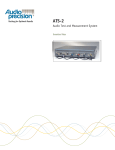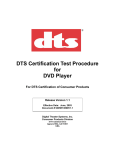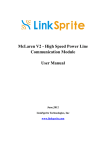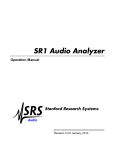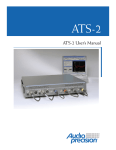Download ATS-1_48k_datasheet
Transcript
Testing for Optimal Results ATS-1 Audio Precision Quality in a Low-Cost, Stand-Alone Test Set Unmatched Value ATS-1: Audio Precision Quality in a Stand-Alone Package The ATS-1 family of audio test instruments—at home on the bench, or in a test rack under GPIB control. With thousands of units sold, you’ll find the ATS-1 family of audio analyzers in operation around the world in maintenance, engineering and production facilities. Whether in broadcast, communications, bench or production use, ATS-1 offers a complete easy-to-use audio test set ready for almost any environment. With twelve different measurement functions selectable at the push of a button, ATS-1 is comprehensive while remaining user-friendly. Its popularity is no less due to its outstanding performance specifications; yet ATS-1 is as affordable as lower-performing test sets. Analog Only or full Dual Domain—Analog and Digital The ATS-1 System replacement for obsolete equipment: HP8903B emulation mode over HPIB (GPIB) ATS-1 Access includes comprehensive analog generation and measurement, with two outputs and two inputs. Easy-to-set-up sweep capability produces graphs of frequency response, distortion vs. frequency and even amplitude sweeps. Non-volatile storage of up to 30 tests allows easy one-button recall of your favorite test setup. Connect ATS-1 to a compatible printer and produce reports incorporating high-resolution graphs. If you work with digital audio, the ATS-1 Dual Domain® model adds AES3/SPDIF audio and interface measurement ca- Unparalleled Precision pabilities to the comprehensive analog capabilities of the ATS-1 family. Low Distortion Analog+Digital+AES3/SPDIF: the ATS-1 Dual Domain Analog System THD+N 80 kHz BW –92 dB ATS-1 Dual Domain® is a comprehensive audio test set for both analog and digital audio, as Digital Distortion THD+N £–140 dB well as for generation and measurement of AES3/SPDIF digital interface characteristics such High Analog Bandwidth as jitter. Like our 2700 Series family of instruments, ATS-1 Dual Domain features true dual Signal Generation to 120 kHz domain architecture. Digital signals are generated and measured purely in the digital do- Low Noise main, resulting in the extremely low distortion and noise residuals necessary for making 22 Hz–22 kHz < –114 dBu useful digital audio measurements. A-weighted < –118 dBu Wide Input Voltage Range Input Range 80 mV–250 V in 10 dB steps Flat Response 20 Hz–20 kHz ±0.05 dB Low Crosstalk Input < –120 dB Output < –110 dB Low Jitter Generator < 0.8 ns Analyzer < 1.6 ns Performance, Measurement Power, and Ease-of-Use Easy to Use Analog Performance: Measurement functions are simply selected The low distortion transformer-coupled ana- from the front panel. Just press a button log generator supplies a full +30.17 dBu and make the used, the setting knobs and measurement. Se- buttons also provide a con- lection of analog venient human interface for and digital inputs scrolling display cursors is clearly indi- and for entry of other set- cated on the front tings and data. panel with LED legends. ATS-1 makes graphs of swept measurements in real time on the high contrast back-lit LCD display, including both frequency and amplitude sweeps. Hard copy high-resolution graphs, (+29.5 dBm into 600 W) at selectable (50 W, 150 W or 600 W) source impedances. Extremely low analyzer noise and residual distortion support measurement of high performance digital devices. Analog Convenience Functions: In addition to the above measurements, the Stereo: ATS-1 Dual Domain is a true two channel instrument. Both analog and digital level functions measure both inputs simultaneously. Phase and level ratio measurements are also available. Full Range of Analog & Digital Testing Facilities: ATS-1 Dual Domain provides complete and analog GEN LOAD function measures the input resistance of your device at any frequency you choose and makes swept impedance measurements (including loudspeakers). AC MAINS CHECK measures the voltage, frequency and distortion of the power line without hazardous direct connections. BARGRAPH display in AC MAINS CHECK function provides a visible history of maximum and minimum mains voltage excursions. compact screen-sized graphs or tabular data parallel measurement capabilities for both listings can be made from your ATS-1 to la- analog and digital audio signals. Measure- ser or ink jet printers at the touch of a ments common to both domains include: button. Bargraphs can display measure- Amplitude, Noise, Level (2 channels simul- ments ranging from AC mains power line taneously), Frequency, Phase, THD+N, distortion to digital interface error rate SMPTE/DIN, IMD, Crosstalk and Level Ratio. The dBg unit (dB referred to the present an- …and nearly everything in between. Sepa- Standard A-weighting, CCIR 468, and LP/HP alog generator amplitude) is useful for filters are included in both domains. RMS compression threshold measurements or and quasi-peak (CCIR 468) detectors are rapid response sweeps at several different available in both domains. absolute levels, as well as for input to output gain/loss measurements. 600 W Analog Input Terminations are indi- rate buttons and knobs provide independent vidually switchable for each channel of the control of frequency and amplitude. The analog analyzer. buttons provide large and medium steps (decade and 1/3 octave steps for frequency, 10 dB and 1 dB for amplitude), with knobs for finer resolution. When not otherwise Turn on ATS-1: Audio Testing to Meet Your Challenges Comprehensive Analog and Digital Functions Digital Performance: fect on THD+N, IMD, or noise. Competitive ATS-1 Dual Domain uses a true DSP-imple- units can drive only one domain at a time mented analyzer for digital measurements, or use their analog generator to create the which results in –130 dB residual THD+N, digital jitter, and thus can’t make this mea- 0.01 dB flatness, and –140 dBFS residual surement at all. noise. Other mixed-signal test sets in the Separate Digital Inputs & Outputs: jitter meter: a 700 Hz high-pass filter used for residual jitter measurements according to AES standards, and a 50 Hz high-pass filter for jitter response measurements. Other Interface Signal Measurements: ATS-1 Dual Domain measures key digital I/O interface parameters in addition to jitter, including sample rate, AES signal voltage, frame delay through the device under test, and delay of the input signal relative to a same price range have no digital analyzer, house sync reference (frame or block). but use a D/A converter and an analog analyzer. These architectures “bottom out” at –70 dB to –84 dB residual THD+N (12–14 bit effective performance), and 0.1 dB flatness. With today’s best A/D converters measuring –108 to –112 dB THD+N, their real performance is invisible to these mixed signal analyzers …buried under the analyzer’s noise and distortion floor. A competitive instrument lacking a DSP analyzer produces false THD+N readings (red trace) from a popular A/D converter; but both the ATS-1 Dual Domain and the Audio Precision 2700 Series graph the true performance of the converter (from 5 dB to 28 dB lower), as shown by the blue trace. Separate & Independent Analog & Digital Generators: Often necessary for dual domain testing. You may, for example, drive the inputs of an A/D converter with the low-distortion analog sine while simultaneously driving the converter’s digital reference (house sync) input with the digital generator. Then, add jitter or vary the sample rate to see the ef- Three I/O formats: XLR, BNC, and optical (Toslink®). All are completely separate from the analog audio XLR connectors, permitting both digital and analog generators to operate simultaneously. No cable changes Flexible Interface Impairment Simulation: required to go from A/D to D/A to D/D to Flexible digital interface testing is vital for A/A testing of a digital tape machine, for troubleshooting and verifying performance example. of digital audio at the systems level. ATS-1 Dual Domain allows simulation of real world Digital & Analog Monitors: transmission and interface problems. Listen to all measurements in the digital and analog domains over the internal loudspeaker or a pair of headphones. In the analog domain, monitor signals or distortion. In the digital domain, the incoming signal, distortion, or jitter can all be monitored. Jitter Meter: ATS-1 Dual Domain includes jitter measurement in nanoseconds or in Unit Intervals. Two filter selections are provided for the Vary the digital output signal to test the acceptance range of your digital devices. Set sample rate anywhere from 28.8 kHz to 52.8 kHz, not just at the three standard frequencies. Inject jitter amplitude from 0 UI to 2.5 UI (415 ns at 48 kHz) in 0.01 UI (1.6 ns) steps, or 0 UI to 25.5 UI (4150 ns) in 0.1 UI (16 ns) steps. Injected jitter frequency can be set from 10 Hz to 38.8 kHz, not just to a fixed frequency. Adjust output signal amplitude Dither amplitude is automatically set to the continuously from zero to 5.12 Volts in proper value for the output word length 5 mV increments, not just at a few steps. and the selected probability function. Independent Interface I/O Word Lengths: Sample & Frame Sync: Word length (resolution) of digital input Synchronize ATS-1 Dual Domain sample and and output are independently set from 16 frame sync to the digital reference (house to 24 bits. Output resolution is set to match sync) input. the device under test to assure proper analysis techniques are compatible with the dither. Input resolution must be set to ex- BITTEST feature of our System products, so clude signal in the AUX bits or other low- you can test a transmission link end-to-end Digital Pass Mode: level bit activity meaningless to the desired with an ATS-1 Dual Domain at one end and a Sends the input digital audio content to measurement. System Two, Cascade or 2700 Series dual the output while modifying status bytes, domain instrument at the other. validity bit, etc. ATS-1 Dual Domain can thus be used as a problem-solver between Other Digital Convenience Functions: incompatible equipment. Digital Status bytes are displayed and set in Independent Input & Output Sample Rates: high-level English. Signal Monitoring Outputs: A digital signal appropriate for syncing an Lets you test sample rate converters. Mea- external oscilloscope may be derived from surement of the incoming embedded audio the input sample rate, output sample rate, signal can be referred to the incoming sam- input block rate, output block rate, digital ple rate, status byte indication of rate, or audio waveform, jitter signal, or the de- the outgoing generator rate. tected interface errors. A buffered version of the balanced AES3 signal from the XLR input is also available, which coupled with Error flag displays for confidence, lock, cod- Dataü Error Testing Capability for Digital Audio Signals: Stimulate the test device with random data and display current or totaled error measurements on both channels. The signal and ing, parity errors and the validity bit are included. Additional active bit and actual bit displays on the panel help determine the word length of the incoming signal and detect stuck bits. Digital Dither: ATS-1 Dual Domain includes a full complement of dither selections—triangular and rectangular probability distribution functions; white or shaped spectrum. the high input impedance of the XLR in bridging mode allows non-intrusive digital line measurements with conventional ground-referenced oscilloscopes. Connectivity, Test Results and GPIB or HPIB Automation tings and on-line help to speed up code development. Measurement sweep data is Versatile Connectivity stored in the instrument for quick batch Choose among three different analog con- transfers without holding up GPIB bus nector panels for your ATS-1. The connector traffic. panel can be mounted on the front of your instrument for convenience, or on the rear Settled GPIB Readings: of the instrument if you’d prefer your ATS-1 Reliable measurements are assured by algorithms inside the instrument which automatically compensate for varying device settling speeds. Settling can be disabled for measurements of jitter or other ATS-1 prints graphs, panel setups and mea- hard-wired in a rack. All the panels come with extra dual banana and ground lugs. The XLR panel allows for either balanced or unbalanced measurements by using a simple dual banana-to-BNC (or to RCA phono) instantaneous values. sured data either to laser (PCL compatible) or inkjet printers. Front panel keys select GPIB Software Drivers two sizes of graph output (including cursor Audio Precision supports the ATS-1 with a data), tabular sweep data, bargraphs and National Instruments LabView and front panels for printing. LabWindows CVI driver for C and Basic pro- adapter. grammers. The LabWindows driver runs with Save & Recall Tests: for personal computers. The driver speeds National Instruments GPIB interface cards development of test routines by eliminating Save 30 instrument set- the need to learn the ATS-1 programming ups, including sweep re- mnemonics. sults data, time-stamped from the internal clock HP8903B GPIB Emulation Mode calendar. Use for repeatable, easy bench and production testing or when in the field, for storing test ATS-1 also emulates the HP8903B audio analyzer HP command set for a simple data to be printed or analyzed later. Each saved test includes all settings for the entire instrument, a default description or your own title for the test, the date and time, and the last test sweep result data. IEEE-488.2 GPIB Port: An IEEE-488.2 GPIB interface port is included on the ATS-1. The commands closely model the front panel interface to make software development more productive. ATS1 provides full query back of all manual set- replacement of slow and outdated equipment in existing systems. A front panel button selects between the Audio Precision 488.2 (GPIB) command mode and the HPIB command mode. ANALOG SIGNAL OUTPUTS Low Distortion Sine Wave Frequency Range Frequency Accuracy Amplitude Range Balanced Unbalanced 10 Hz to 120 kHz ±0.5 % (20 Hz to 30 kHz) <0.25 mV to 26.25 Vrms [–70 dBu to +30.6 dBu] <0.25 mV to 13.12 Vrms [–70 dBu to +24.6 dBu] ±0.2 dB [±2.3 %] at 1 kHz 0.01 dB Amplitude Accuracy Amplitude Resolution Flatness (1 kHz ref) 10 Hz–20 kHz ±0.05 dB Residual THD+N 25 Hz–20 kHz £(0.0025% + 3 µV), 80 kHz BW [–92 dB] Square Wave Frequency Range 20 Hz–30 kHz Amplitude Range Balanced 0.71 mVpp to 34.73 Vpp Unbalanced 0.71 mVpp to 17.36 Vpp Amplitude Accuracy ±0.3 dB [±3.5 %] at 400 Hz Rise/fall time Typically 2.5–3.0 µs SMPTE (or DIN) Test Signals with option “ATS-IMD” LF Tone 50, 60, 70, or 250; all ±1.0 % HF Tone Range 7 kHz or 8 kHz (±1 %) Mix Ratio 4:1 (LF:HF) Residual IMD 0.0015 % [–96.5 dB], 60 Hz + 7 kHz or 250 Hz + 8 kHz OUTPUT CHARACTERISTICS Source Configuration Selectable balanced or unbalanced Source Impedances Balanced 50 W (±2 W), 150 W (±2 W), or 600 W (±6 W) Unbalanced 50 W (±2 W) Output Current Limit 75 mA peak Max Output Power Balanced +29.9 dBm into 600 W (Rs = 50 W) Unbalanced +23.8 dBm into 600 W (Rs = 50 W) Output Related Crosstalk £–110 dB or 10 µV, whichever is greater (10 Hz–20 kHz) ANALOG ANALYZER ANALOG INPUT CHARACTERISTICS Input Ranges 80 mV to 250 V in 10 dB steps Maximum Rated Input 350 Vpk, 140 Vrms (dc to 20 kHz); overload protected Input Impedance Balanced (each side) Nominally 100 kW // 150–200 pF Unbalanced Nominally 100 kW // 150–200 pF Terminations Selectable 600 W ±1 % CMRR 80 mV–2.5 V range ³70 dB, 50 Hz–20 kHz Input Related Crosstalk £–120 dB or 1 µV, whichever is greater 10 Hz–20 kHz Wideband Amplitude/Noise Function Measurement Range <1 µVrms to 140 Vrms [–118 dBu to +45 dBu] Accuracy (1 kHz) ±0.2 dB [±2.37 %] unweighted Flatness (1 kHz ref) ±0.05 dB (20 Hz–20 kHz) Bandwidth Limiting Filters LF –3 dB <10 Hz; 400 Hz ±5 % (3-pole) HF –3 dB 22 kHz; 30 kHz; 80 kHz (3-pole), or 300 kHz Weighting Filters ANSI-IEC “A”; CCIR-QPK; CCIR-ARM; CCIR-RMS Optional Filters Up to 2 (Aux 1 and Aux 2) Detection RMS (i=60 ms); AVG; QPK (CCIR Rec 468) Residual Noise 22 Hz–22 kHz BW £1.5 µV [–114 dBu] A-weighted £1.0 µV [–118 dBu] CCIR-QPK £5.0 µV [–104 dBu] Frequency Meter Related (both channels) Measurement Range 10 Hz–200 kHz Accuracy ±0.01 % [±100 PPM] Resolution 5 digits Phase Measurement Related Measurement Ranges ±180, +90/–270, or –90/+270 deg Accuracy 20 Hz–20 kHz ±2.0 deg Resolution 0.1 deg Level Meter Related (both channels) Measurement Range 10 mV to 140 V for specified accuracy and flatness, useable to <100 µV [–38 dBu to + 45 dBu] Accuracy (1 kHz) ±0.1 dB + 100 µV Flatness (1 kHz ref) (Vin >10 mV) ±0.05 dB (20 Hz–20 kHz) Bandpass Amplitude Function Tuning Range (fO) 20 Hz to 120 kHz Bandpass Response Q=5 (2-pole) Accuracy (at fo) ±0.3 dB, 20 Hz–120 kHz THD+N / SINAD Function Fundamental Range 10 Hz to 100 kHz, THD+N mode Measurement Range .001 %–100 % SINAD Range 400 Hz–1 kHz Accuracy ±1 dB, 20 Hz–120 kHz harmonics Measurement Bandwidth LF –3 dB <10 or 400 Hz HF –3 dB 22k, 30k, 80k, or 300 kHz Residual THD+N 25 Hz–20 kHz £(0.0025% + 3.0 µV), 80 kHz BW [–92 dB] Crosstalk Function Frequency Range 10 Hz to 120 kHz Measurement Range –140 dB to 0 dB Accuracy ±0.5 dB SMPTE (DIN) IMD Function with option “ATS-IMD” Test Signal Compatibility 40–250 Hz and 3 kHz–20 kHz in 0:1 to 8:1 ratio IMD Measured Amplitude modulation products of the HF tone. Measurement Range <0.0025 %–20 % Accuracy ±1 dB per SMPTE RP-120-1983, DIN 45403 Residual IMD £0.0025% [–92 dB], 60 + 7 kHz or 250 + 8 kHz Wow & Flutter Function Test Signal Compatibility 2.80 kHz–3.35 kHz Accuracy (4 Hz) ±(5 % of reading + 0.002 %) Detection Modes IEC/DIN; NAB; JIS Residual W+F £0.005% Weighted; £0.01% Unweighted DIGITAL SIGNAL GENERATOR DIGITAL OUTPUT CHARACTERISTICS Output Formats AES/EBU (per AES3-1992); SPDIFEIAJ; Optical Sample Rates 28.8 kHz–52.8 kHz Sample Rate Accuracy ±0.002% [±20 PPM] lockable to external reference Word Length 16 to 24 bits (even values) Sine Wave Frequency Range 10 Hz to 47 % of sample rate (22.56 kHz at 48 ks/s) Frequency Resolution Sample Rate ¸ 223 (typically 0.006 Hz at 48 ks/sec) Flatness ±0.001 dB Residual Distortion ±0.00001 % [–140 dB] Square Wave Frequency Range 10 Hz to 1/6 sample rate Frequencies available fs ¸ 4096 to fs ¸ 6, in even integer divisors SMPTE/DIN IMD Waveform with option “ATS-IMD” Upper Tone Range Choice of 7 kHz or 8 kHz Lower Tone Range Choice of 50 Hz, 60 Hz, 70 Hz, or 250 Hz Amplitude Ratio 4:1 (LF:HF) Residual Distortion £0.00001 % [–140 dB] at 4:1 ratio Random Generator Waveform Waveform Compatible with Audio Precision BITTEST Dither (all waveforms) Probability Distribution Triangular or rectangular; independent for each channel Spectral Distribution Flat (white) or Shaped (+6 dB/oct, triangular only) Amplitude Automatically tracks word length or off AES/EBU INTERFACE GENERATION Interface Signal Amplitude Range Balanced (XLR) Unbalanced (BNC) Channel Status Bits Validity Flag AES/EBU Impairments Induced Jitter Jitter Freq Range Jitter Amplitude 0–5.11 Vpp, into 110 W in 5 mV steps 0–1.62 Vpp, into 75 W in 1.6 mV steps English language decoded, Professional/Consumer Selectable, set or cleared Sine wave 10 Hz to 38.8 kHz 0–1.28 UI (pk), in steps of 0.005 UI or better 1.3–12.75 UI, in steps of 0.05 UI or better (total generator/analyzer) peak calibrated £0.005 UI (700 Hz–30 kHz BW) £0.015 UI (700 Hz–30 kHz BW) Residual Jitter RMS response Peak response Spurious Jitter Products Jitter & Ref Delay Off £0.0005 UI Jitter On £–30 dB below jitter signal REFERENCE INPUT CHARACTERISTICS Input Formats AES/EBU (per AES3-1992) Input Sample Rates 28.8 kHz–52.8 kHz Lock Range ±0.0025% [±25 PPM] Narrow Band Amplitude Frequency Range Filter Shape THD+N Measurements Fundamental Range 0.04% to 40% of sample rate (10 Hz–19.2 kHz at 48.0 ks/sec) 10-pole, Q=19 (BW = 5.3% of f0) 0.02% to 45% of sample rate (10 Hz–22.0 kHz at 48.0 ks/sec £–138 dBFS 22 Hz, 400 Hz 2-pole Butterworth 15 kHz, 20 kHz 6-pole elliptic lowpass Weighting Filters ANSI-IEC “A” weighting; CCIR QPK; CCIR RMS SMPTE (DIN) IMD Function with option “ATS-IMD” Test Signal Compatibility 40–250 Hz and 3 kHz–20 kHz in 1:1 to 4:1 ratio IMD Measured Amplitude modulation products of the HF tone. Measurement Range <0.0001%–10% Accuracy ±1 dB per SMPTE RP-120-1983, DIN 45403 Residual IMD (0 dBFS) £0.0001% [–120 dB], 60 + 7 kHz or 250 + 8 kHz Frequency Measurements Range 5 Hz to 47% of sample rate Phase Measurement Related Measurement Ranges ±180, +90/–270, or –90/+270 deg Accuracy ±2.0 deg (20 Hz–20 kHz) Resolution 0.1 deg BITTEST Measurement Measurement Compatible with random mode of Audio Precision BITTEST Residual THD+N High pass Filters Low pass Filters DIGITAL INTERFACE MEASUREMENTS AES/EBU Impairments, Real Time Displays Input Sample Rate ±0.002% [±20 PPM] internal ref, ±0.0001% [*1 PPM] external ref Output to Input or Reference Measures status propagation from the AES/EBU output to the input. Input to Input Delay Range is 0–192 (frames), resolution ±60 ns. AES/EBU Input Voltage Balanced 400 mV to 10.24 Vpp, ±(10% + 50 mV) Unbalanced 100 mV to 2.56 Vpp, ±(10% + 30 mV) Jitter Amplitude (500 Hz) (peak-peak sine wave calibrated) 0–10 UI, Jitter Flatness ±1.5 dB, 100 Hz–22 kHz (50 Hz HP selection, RMS detection, 48 kHz sample rate) Residual Jitter, peak calibrated (analyzer only) (700 Hz–30 kHz BW)£0.01 UI RMS; £0.03 UI Peak Spurious Jitter Products £0.002 UI (1.2 kHz) or 0 dB below jitter signal Channel Status Bits English language decoded (Professional/Consumer) Validity Flag Displayed for selected channel Parity; Signal Confidence; Displayed for total signal (both channels combined) Receiver Lock; Coding Error AUXILIARY SIGNALS Generator Analog Sync Output; Digital Sync Output; Analyzer Input Monitor; Analyzer Reading AUDIO MONITOR Power Output Typically 1 watt GENERAL / ENVIRONMENTAL Power Requirements Temperature Range DIGITAL ANALYZER Humidity DIGITAL INPUT CHARACTERISTICS Input Formats AES/EBU (per AES3-1992); SPDIFEIAJ; Optical Sample Rates 28.8 kHz–52.8 kHz Word Length 16 to 24 bits EMBEDDED AUDIO MEASUREMENTS Wideband Level/Amplitude Range 0 dBFS to –140 dBFS Frequency Range <10 Hz–22.0 kHz at 48 ks/sec Accuracy ±0.01 dB, ³–90 dBFS Flatness ±0.01 dB, 15 Hz–22 kHz High pass Filters 22 Hz, 400 Hz, 2-pole Butterworth Low pass Filters 15 kHz, 20 kHz 6-pole elliptic lowpass Weighting Filters ANSI-IEC “A” weighting; CCIR QPK; CCIR RMS Residual Noise –140 dBFS unweighted; –142 dBFS A-weighted EMC Dimensions Weight Safety 100/120/230/240 Vac (–10%/+6%), 50–60 Hz, 50 VA max 0° C to +50° C Operating; –20° C to +60° C Storage 90% RH to at least +40° C (noncondensing) Complies with 89/336/EEC, CISPR 22 (class B), and FCC 15 subpart J (class B) 16.5 x 6.0 x 13.6 inches [41.9 x 15.2 x 34.5 cm] Approximately 20 lbs [9.1 kg] Complies with 73/23/EEC, 93/68/EEC, EN61010, and IEC 1010 (including Amendments 1 and 2) ATS-1 Dual Domain Block Diagram WOW & FLUTTER DISCRIMINATOR CHANNEL A SQUARE WAVE GENERATOR MEASUREMENT AMPLIFIER BAND PASS BAND REJECT FILTER INPUT TERMINATION ANALOG INPUT INPUT PREAMP and ATTENUATOR PRIMARY READING DETECTOR WEIGHTING FILTERS SOURCE IMPEDANCE OUTPUT ATTENUATOR MAIN OSCILLATOR PHASE/FREQ COMPARATORS CHANNEL B OUTPUT AMPLIFIER SIGNAL SUMMATION SECONDARY READING DETECTOR CHANNEL A ANALOG OUTPUT BALANCING TRANSFORMER CHANNEL B INPUT TERMINATION INTERMOD DEMODULATOR ANALOG TRIGGER OUTPUT FUNCTION MONITOR IMD HF TONE GENERATOR INTERMODULATION DISTORTION OPTION INPUT MONITOR SPEAKER/ HEADPHONE MONITOR MICROPROCESSOR LCD DISPLAY IEC60958 INPUT AC/DC M U X AES3 INPUT OPTICAL INPUT AES3 RECEIVER MONITOR D-to-A JITTER DETECTOR A-to-D DSP Generator Waveform Trigger OPTICAL RECEIVER Jitter Signal Output Clock DELAY LOGIC AES3 REFERENCE INPUT M U X Input Clock CLOCK GENERATOR SYNC JITTER GENERATOR IEC60958 OUTPUT AES3 TRANSMITTER JITTER MODULATOR AES3 OUTPUT DRIVER OPTICAL DRIVER BUYING AN ATS-1 ANALYZER FOR ANALOG AND DIGITAL AUDIO: Ordering Information ATS-1A ATS-1 Access Audio Test System with GPIB interface ATS-1DD ATS-1 Dual Domain (digital and analog) Audio Test System with GPIB interface Select panel type and front or rear connections at time of order: ATS-BNC: BNC and banana jack connector panel ATS-XLR: XLR and banana jack connector panel ATS-PHJ: ¼-inch phone and banana jack connector panel ATS-R: Rear mount (front mount connector panel is default) Options and Accessories for ATS-1 Instruments ATS-IMD SMPTE/DIN intermodulation distortion measurement and generation (analog and digital) RAK-ATS Rack mount shelf for ATS-1 Access or ATS-1 Dual Domain MAN-ATSA Additional ATS-1 Access operator’s manual (one included with instrument) MAN-ATSDD Additional ATS-1 Dual Domain operator’s manual (one included with instrument) MAN-ATS488 Additional GPIB manual for ATS-1 Access or ATS-1 Dual Domain (one included with instrument) SVC-ATS Service manual for ATS-1 Access or ATS-1 Dual Domain CAB-XMF Set of four XLR male to XLR female cables CAB-XBR Set of four XLR male/female to RCA/BNC cables CAB-AES Set of two AES3 digital cables, 1 meter CAB-AES2 Set of two AES3 digital cables, 2 meters CAB-AES4 Set of two AES3 digital cables, 4 meters ATS-1 includes a removable carrying handle. Portable and self-contained, take your ATS-1 with you on the road. pn 0057.0002 rev 0 What to look for when evaluating competitive instruments Digital Architecture and Features: Not all analyzers that accept a digital input signal are actually digital analyzers. Does the instrument have a real (DSP-implemented) digital domain analyzer, or just a D/A converter from the digital input connector to an analog hardware analyzer? This latter approach in a competitive unit yields distortion performance in the 12–14 bit range (–70 to –85 dB THD+N, for example). There’s just not that much 12-bit digital audio around to measure anymore. ATS-1 Dual Domain’s digital analyzer guarantees –130 dB residual distortion (nearly 22 bit performance), far in excess of the –108 to –112 dB actual linearity of today’s best A/D converters. Analog Performance: Does the instrument have an analog hardware generator and an analog hardware analyzer? Some competitive units (at twice the price of ATS-1 Dual Domain) use DSP techniques for all generation and analysis, so analog signals pass DIGITAL TRIGGER OUTPUT OPTICAL OUTPUT through converters inside the instrument. The result is THD+N as high as –79 dB, flatness as poor as –0.2 dB —inadequate for most modern audio devices. Interface Testing: Does the instrument have independent analog, digital, and jitter generators? If it can only provide analog or digital output at any one time, you can’t test a house-synchronized A/D converter for jitter rejection. Without independent, flexible digital audio and jitter generators, you can’t measure jitter sensitivity of a D/A converter at various audio and jitter frequency combinations. True Dual Domain: True Dual Domain hardware by definition guarantees a full range of analysis capabilities in both analog and digital domains. Everyone measures level and some measure THD+N (although implemented with extremely limited performance, as noted above). Be sure that other useful measurements such as IMD (Intermodulation Distortion), Phase, and Crosstalk are available for both analog and digital signals, not just analog. Testing for Optimal Results 5750 SW Arctic Drive Beaverton, Oregon 97005 Tel 503-627-0832 Fax 503-641-8906 US Toll Free 1-800-231-7350 email: [email protected] web: audioprecision.com XI0607170000








